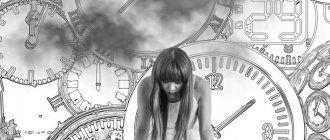The nature of antisociality
The main reasons underlying antisocial behavior are predetermined by the following factors: biological, social, personal.
Antisociality is formed under the influence of individual characteristics, as well as specific life circumstances. Such a personality is characterized by: distortion of value orientations, limited interests and needs, antisocial ways of satisfying them.
Biological factors explain the formation of antisociality by the characteristics of the relationship between parent and child, special thinking styles that contribute to the development of antisocial behavior.
Research has shown that criminal antisocial behavior is based on genetic predisposition.
Antisocial individuals seek additional stimulation, sensations that only dangerous and impulsive actions can provide.
Note 2
The formation of antisocial behavior is greatly influenced by the social environment surrounding the individual.
The development of antisocial behavior in children with a tendency to hyperactivity and behavioral disorders strongly depends on the quality of parental care.
The best indicator of child behavior disorders is the level of parental supervision. Patterns of antisocial behavior are more likely to develop in children who are often left without adequate adult supervision for long periods of time.
The formation of antisociality is facilitated by parental indifference, physical violence, hostility towards children, and ridicule.
Family and biological factors that contribute to the formation of behavioral disorders often coincide.
Antisocial individuals have neuropsychological problems, which may be due to maternal drug use, insufficient intrauterine nutrition, complications during childbirth, toxic exposure, or maternal abuse during pregnancy.
Children with neuropsychological disorders are impulsive, more irritable than their peers, inattentive and overactive,
In children with a tendency toward antisocial behavior, information about social interactions is analyzed in such a way that aggressive reactions are developed in response. Any negative action directed at them is perceived as intentional.
Manifestations of antisocial behavior are persistently repeated, regular, repeated and long-lasting. Often this behavior is predictable. A person loses the ability to communicate normally with people around him.
Antisocial behavior does not appear as a result of a difficult life situation (psychological trauma, illness), but can be caused by its cause.
Causes
There are a number of theories that partially explain the reasons for the development of an antisocial personality:
Psychodynamic. In most cases, sociopathic children did not receive proper parental care and attention
Because of this, they withdrew into themselves and tried to attract attention through unmotivated cruelty - gaining attention through destructive dialogue. Often one of the parents showed cruelty towards a child or spouse or abused alcohol
This could also have a strong impact on an emotionally unstable psyche; Behavioral. It is directly similar to the first theory due to the fact that parents always serve as an example for the development of a child. If one of them, for some reason, behaves aggressively, inappropriately, and regularly shows his influence on other people, this is embedded in the child at a subconscious level as “correct” behavior. And, accordingly, finding himself in one situation or another, he will imitate his idol. Sometimes actors, musicians, etc. contribute to the development of a sociopathic personality; Cognitive. It is also a feature of behavior - reinforcement of the wrong point of view by parents, friends, television, etc.; Biological. It is caused by the slow excitation of the nervous system in response to external stimuli, this contributes to the desire to commit an illegal act and get more thrills.
Stages of formation
Antisocial personality disorder never arises out of nowhere and is characterized by the denial of any values and/or norms of modern society. A sociopath is angry, impulsive, lies a lot, and is completely incapable of reacting to the mood of other people, hence the emotional coldness. The first appearance of signs is observed in childhood or adolescence, when particular cruelty towards peers, violence against animals, and against young children is striking. It is worth noting that a child suffering from sociopathy will not choose an opponent who is “equal” in all respects; he prefers weaker ones who are unable to stand up for themselves. This description fits perfectly with an epileptoid personality type; many sociopaths are found among bosses and other persons responsible for the work of a group of people. A sociopath, being in puberty, skips classes, runs away from home, damages other people's property and promotes violence. He himself looks for conflicts and, as a rule, finds them. At older ages, dissocial personality disorder sometimes goes away on its own or declines; the reasons for this behavior are not well understood. However, the vast majority continue to engage in criminal activities.
Antisocial personality
We are talking about a person whose all actions come down to satisfying his own desires (often these are only physiological needs). Such people do everything only for themselves, without regard for others, without taking into account their desires and needs. For asocial people there are no moral principles, they do not feel guilty for their actions, and are not afraid of punishment for illegal actions. All these deviations from social norms of behavior entail a tendency to alcoholism, drug addiction, promiscuity, and criminal activity.
Signs of an antisocial personality
- impulsiveness, aggressiveness
- all human actions come down to the momentary fulfillment of one’s desires (needs)
- lack of shame, feelings of guilt for one’s actions
- a sharply negative reaction to interference in their affairs
- inability to change one's behavior (even after punishment)
- inability to sympathize with others and take into account their interests
- tendency to lie, pretend
- shifting responsibility and blame to others
Thus we move on to the next term.
Diagnostic measures
To identify deviations, specialists use several methods. These include:
- Interviews and observation. In the process of talking with the teenager’s parents, the peculiarities of the relationship between family members are clarified. The psychologist also pays attention to the patient’s behavior (adequacy of judgment, emotions, presence of aggression).
- Questionnaires. This method allows you to determine the tendency to crime, cruelty, addictions, and sexual pathologies.
- Additional information received from doctors, local police officers, and teachers.
Types of such behavior
Depending on the norm of behavior accepted by society that a person violates, antisocial (“antisocial”) behavior can be classified into types.
- Violation of the law and legal norms that threatens the well-being and social status of people. In other words, committing a crime.
- Behavior that is contrary to social, moral and ethical norms in society.
- Blindly following the chosen ideal (idol) and adherence to its ideas is defined as fanaticism and conformism. Narcissism, that is, developing a sense of self-importance, greatness, grandiosity.
- All kinds of addictions (dependencies) and suicidal tendencies, which form in an individual of any age, even in children, self-destructive or self-destructive behavior.
Types of antisocial behavior
Depending on what areas of society the violation affects, there are 4 forms:
- Illegal actions. These include theft of cars, motorcycles, insults, and fights.
- Criminal actions. This is the commission of actions that contradict the laws established in the state. Such manifestations include violence, robbery, banditry, racketeering, and murder.
- Immoral behavior (not consistent with generally accepted moral standards). These are homosexuality, promiscuity, refusal to work, and vagrancy.
- Addiction. Its types include alcohol and drug use, computer game addiction, anorexia and bulimia.
Psychiatrists' opinion
There are many circumstances that contribute to the development of deviation. Experts say that it may be associated with biological reasons, characteristics of upbringing, or a certain way of thinking. There are two concepts - antisocial behavior and antisocial. How are they different? Many scientists associate these phenomena with the presence of mental disorders. Psychiatrists distinguish two types of individuals with such deviations. According to this point of view, antisocial individuals include:
- People who have isolated themselves from society. They have a special inner world. There is almost no contact with others. The experiences of such individuals, their emotions, attachments are not manifested externally and are unknown to others. The isolation of such individuals does not cause them suffering. Low-income people with this disorder become vagabonds. The rich are gaining a reputation as eccentric eccentrics.
- Persons who are unable to establish contacts with others. They cannot function normally in society and experience great suffering as a result. Such an individual perceives any interaction as torture. Therefore, he tries with all his might to hide from others. Others notice oddities in a person’s behavior (excessive shyness, unceremoniousness, ridiculous actions) and also instinctively avoid communication. As a result, the antisocial personality is deprived of friendship and romantic relationships. Such people are forced to spend a lot of time at home and not go anywhere. They worry about being unable to realize themselves at work or start a family.
These personality types do not have a negative impact on society.
Psychiatrists' opinion
There are many circumstances that contribute to the development of deviation. Experts say that it may be associated with biological reasons, characteristics of upbringing, or a certain way of thinking. There are two concepts - antisocial behavior and antisocial. How are they different? Many scientists associate these phenomena with the presence of mental disorders. Psychiatrists distinguish two types of individuals with such deviations. According to this point of view, antisocial individuals include:
- People who have isolated themselves from society. They have a special inner world. There is almost no contact with others. The experiences of such individuals, their emotions, attachments are not manifested externally and are unknown to others. The isolation of such individuals does not cause them suffering. Low-income people with this disorder become vagabonds. The rich are gaining a reputation as eccentric eccentrics.
- Persons who are unable to establish contacts with others. They cannot function normally in society and experience great suffering as a result. Such an individual perceives any interaction as torture. Therefore, he tries with all his might to hide from others. Others notice oddities in a person’s behavior (excessive shyness, unceremoniousness, ridiculous actions) and also instinctively avoid communication. As a result, the antisocial personality is deprived of friendship and romantic relationships. Such people are forced to spend a lot of time at home and not go anywhere. They worry about being unable to realize themselves at work or start a family.
These personality types do not have a negative impact on society.
According to psychiatrists, cases of antisocial behavior are characterized by a negative impact on others. Such manifestations include delinquency and criminal behavior. Experts explain such deviations as the development of a serious mental illness.
Influence of close environment
The biggest role in shaping the character of a minor is played by his mother and father. These are the people with whom the child constantly lives and spends a significant part of his time. Educators say that it is not only parents with alcohol or drug addiction who contribute to the development of antisocial behavior in a teenager. Examples of such deviations can be found in families that at first glance seem prosperous. The fact is that the wrong parenting style negatively affects the child’s personality.
This happens when parents are emotionally distant from each other or show callousness towards their son or daughter. Excessive guardianship and the desire to control a teenager also causes him to protest. Violence of a psychological, physical or sexual nature has a particularly strong impact on the development of a child’s psyche. Such young men and women exhibit a craving for alcohol, drug addiction, and a tendency to have disorderly intimate contacts and run away from home.
Poverty also negatively affects self-esteem and relationships with peers. Poor children are subject to ridicule. Another factor contributing to the development of deviations is emotional shock. This could be the development of an illness or mental disorder in one of the family members, the death of a relative, divorce, or a new marriage of the father or mother.
Types of antisocial behavior in people of puberty
The types of this deviation include:
- Nicotine addiction. A teenager starts smoking to feel like an adult. Money that parents give for other purposes is used to buy cigarettes. Addiction to nicotine is associated with unpleasant symptoms (feeling sick, coughing, dizziness). But despite this, adolescents quickly develop addiction and develop dangerous pathologies.
- Addiction to alcohol.
Today it is often found among young people. In many companies, drinking is considered an integral attribute of adult life and fun. Alcoholism in people of adolescence develops quickly due to the immaturity of the body. - Drug use.
- Vagrancy. It arises as a way of withdrawing from society, avoiding problems at school and family.
- Violations of a sexual nature. This is a group of diseases that includes intimate contacts between persons of the same sex, attraction to animals, fetishism, and display of genitals in public places.
- Suicide attempts. This form of antisocial behavior in adolescents occurs as a result of the death of close relatives, failures in their personal lives, loneliness, and addictions.
- Fears and beliefs about the presence of a physical disability. These deviations contribute to the teenager’s isolation from his peers and isolation.
- Strange hobbies, fantasies.
- Gambling addiction.
- Offenses.
Signs of violations
Symptoms of antisocial behavior can vary. Some people experience such deviations as vagrancy, addictions, use of obscene language, and aggression towards relatives. Such manifestations cause suffering only to those who live next to this person or communicate closely with him. Other signs (pranks on the phone, drawing graffiti, vandalism, theft) are considered offenses. Persons who commit these acts end up in the police department.
Prevention of antisocial behavior
Early intervention is the key to preventing antisocial behavior. The Center for Effective Collaboration and Practice shows that schools develop and implement three different prevention strategies.
Primary prevention
This would include student participation in school-wide activities that could deter anti-social behaviour, for example:
- teaching conflict resolution
- anger management skills
- emotional literacy
Secondary prevention
It is intended for students who are at risk of developing antisocial tendencies and engaging in individual activities, including:
- specialized lessons
- small group social skills lessons
- consulting
- mentoring
Tertiary prevention (treatment)
The third stage continues with intensive counseling. This applies to antisocial students and students with chronic forms of crime and aggression. The center envisions families, counselors, teachers and others coordinating efforts to treat children with antisocial behavior.
How to prevent the development of disorders?
Prevention of antisocial behavior is as follows:
- Parents and teachers should praise the child only in cases where he has earned approval.
- Negative character traits, addictions and unseemly actions cannot be ignored.
- You must always be prepared for open and calm communication with your child. He needs to feel supported and respected.
- Try to spend as much time as possible with your son or daughter.
- Particular attention should be paid to creating a positive atmosphere in the family, mutual understanding, and organizing joint leisure time.
- Parents and teachers need to instill in their children a desire for creativity, sports, and intellectual activity.
Reasons for asociality
The deviant personality type is formed as a result of the following groups of factors:
- medical;
- pedagogical;
- social.
Also, the cause of deviations may lie in psychological pathologies. They arise when several groups of factors are combined and are difficult to treat.
Medical reasons
Schizophrenia is one of the causes of asociality
Medical factors that provoke asociality include:
- lesions of the fetus inside the womb;
- infections and brain injuries;
- psychosomatic abnormalities;
- schizotypal disorder,
- schizophrenic conditions;
- infantilism, ADHD, heboidity.
Pedagogical reasons
Among the causes of deviance manifested due to improper upbringing are:
- negative example of parents and other family members;
- excessively high demands on the child;
- overprotection or lack of guardianship as such;
- ignoring the child's needs;
- indulgence of all whims;
- frequent and unfair punishments;
- lack of trusting relationships in the family.
Excessive care for a person leads to an antisocial lifestyle
Social reasons
The social factors of deviant behavior include the following:
- problems communicating with peers in children and adolescents;
- the desire to assert oneself at the expense of others;
- material and social inequality;
- living in a dysfunctional family;
- influence of religious sects, subcultures;
- bullying, bullying, ridicule;
- physical and sexual violence.
Social reasons also include addictions that provoke deviance.
Reasons for the development of deviations
Antisocial behavior is a pathology that appears as a result of various factors. Such circumstances include:
- Medical reasons. These include maternal illnesses during pregnancy, poor heredity, mental disorders, as well as infectious diseases and mechanical head injuries suffered in childhood.
- Pedagogical factors. This is a bad example of relatives and shortcomings of upbringing. Some mothers and fathers overprotect their children or, conversely, place too high demands on them. This contributes to the formation of behavioral disorders.
- Reasons that are psychological in nature. This is a combination of medical factors and errors in education.
- Social circumstances. These include material disadvantage and bullying from classmates. The presence of relatives suffering from alcohol or drug addiction also has a negative impact on the child.
So, the development of deviations in many cases is associated with an unfavorable microclimate in a person’s family.
By location
United Kingdom
ASBO Alert in London
An Anti-Social Behavior Order (ASBO) is a civil order made against a person who is found to have exhibited anti-social behaviour. The orders, introduced in the United Kingdom by Prime Minister Tony Blair in 1998, were intended to criminalize minor incidents that previously did not require prosecution.
The Crime and Disorder Act 1998 defines anti-social behavior as actions that "have caused, or are likely to cause, harassment, alarm or distress to one or more persons not belonging to the same household" as the offender. There has been controversy regarding the vagueness of this definition.
However, among legal professionals in the UK there are types of behavior that generally fall within the definition of antisocial behavior. This includes, but is not limited to, threats or intimidation, racial or religious harassment, verbal abuse and physical violence.
In a survey conducted by University College London in May 2006, respondents considered the UK to be the worst country in Europe for antisocial behaviour, with 76% believing the UK to have a "major or moderate problem".
The current legislation governing antisocial behavior in the UK is the Antisocial Behavior, Crime and Policing Act 2014, which received Royal Assent in March 2014 and came into force in October 2014. It replaces tools such as ASBO with six improved tools designed to make it easier to tackle anti-social behaviour.
Australia
Antisocial behavior can have negative consequences and affect Australian communities and their perceptions of safety. Western Australia Police define anti-social behavior as any behavior that annoys, annoys, disrupts or prevents people from going about their lawful business. In Australia, many different activities are classified as antisocial behavior, such as misuse of public space, disregard for public safety, disregard for personal welfare, acts directed at people, graffiti, protesting, alcohol-related offences, and drink driving. Australian teenagers have been found to exhibit antisocial behavior at varying levels at high rates. In 1996, 441,234 secondary school students from Years 7 to 12 were surveyed in New South Wales, Australia, regarding their involvement in antisocial activities. 38.6% reported intentionally damaging or destroying someone else's property, 22.8% admitted receiving or selling stolen goods, and about 40% admitted assaulting someone with the intent to harm them. The Australian community is encouraged to report any behavior that raises concerns and play a vital role in helping police reduce anti-social behavior. One study in 2021 found that perpetrators of antisocial behavior may not actually intend to commit an offence. The study examined antisocial behavior (or microaggressions) among the LGBTIQ community on a university campus. The study looked at how many members believed that other people often engaged in antisocial behaviour, but there were no clear hints of any malice behind the actions. Most likely, the criminals were naive about their behavior.
Western Australia Police are using a three-pronged strategy to combat anti-social behavior.
- Prevention - This action uses community participation, intelligence, training and development, and targeting hot spots in an attempt to prevent unacceptable behavior from occurring.
- Response - A timely and effective response to anti-social behavior is vital. The police provide accountability, leadership and coordination in apprehending offenders.
- The solution is to identify the underlying issues causing antisocial behavior and address these issues with the help of the community. The offenders were successfully brought to justice.
Forms of destructive behavior
Destructive behavior has many manifestations, directed both at the person himself and at material and intangible objects of the outside world. Such behavior may have an impulsive, sudden, or calculated effect on the target. Towards the goals of destructive behavior aimed at objects of the external world, Ts.P. Korolenko says:
- destruction of living beings (murder, bullying, torture, cannibalism);
- deliberate violation of social relations (terrorist acts, coups d'etat, revolutions);
- causing harm to objects of the natural environment or inanimate objects..
The following types of destructive behavior are distinguished:
- antisocial (directed against society);
- addictive (resulting from dependence);
- suicidal (directed against oneself);
- fanatical (resulting from a fanatical passion for something);
- narcissistic;
- autistic;
- conformist.
In addition, by type of action it is also possible to distinguish several types of destructive behavior.
First of all, destructive behavior includes destructive intrapersonal behavior, represented by:
- self-destruction;
- self-harm (neglect of vital and social needs, risky behavior, lowering the social status of the individual);
- self-change (body modifications: tattoos, piercings, and mental state: excessive use of alcohol and drugs).
This behavior has a diverse range of practices and manifestations, determined by the socio-demographic characteristics of the individual. So, for example, women more often perceive destructive behavior as a passive form of self-destruction, while men, on the contrary, choose more active forms (development of alcohol addiction, performing dangerous work, extreme sports, risky driving, etc.). Various forms of destructive behavior have a certain connection with age: for example, adolescents and young adults are more susceptible to self-change (tattooing, piercing, plastic surgery and gender reassignment surgery).
The second category of types of destructive behavior is interpersonal behavior. In speech behavior, destruction is manifested in an overestimation of the status of the speaker and a decrease in respect for the interlocutor, which is manifested in the use of criticism, threats and insults. In addition, destructive behavior also manifests itself in the actions of the individual. These actions are also characterized by considerable diversity and are determined by a large number of factors. In this case, destruction is virtually impossible to distinguish from aggression. The individual’s motives may be the low level of social integration of the interlocutor, the desire to maintain or restore positive self-esteem due to previous exposure.
The third category is destructive metapersonal behavior. It is aimed at destroying everything connected with the role of the individual in society as a highly differentiated social structure. A generalization of publications allows us to identify two types of destructive behavior, focused on a person’s relationships and his assigned social role:
- denial, refusal of a social role;
- over-acceptance, merging with one’s social role.
Rejection of a social role is expressed in a person's antisocial, dysfunctional and counterproductive actions in relation to the social structure. The central point of destructive activity is his reluctance to fulfill a social role: labor, education, service, serving a sentence, etc.











